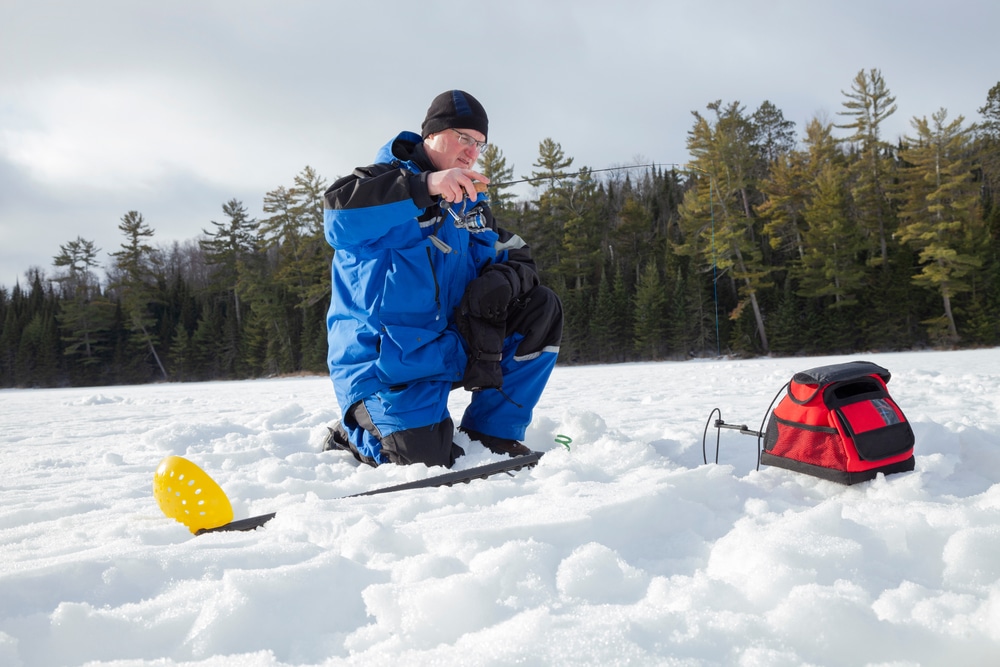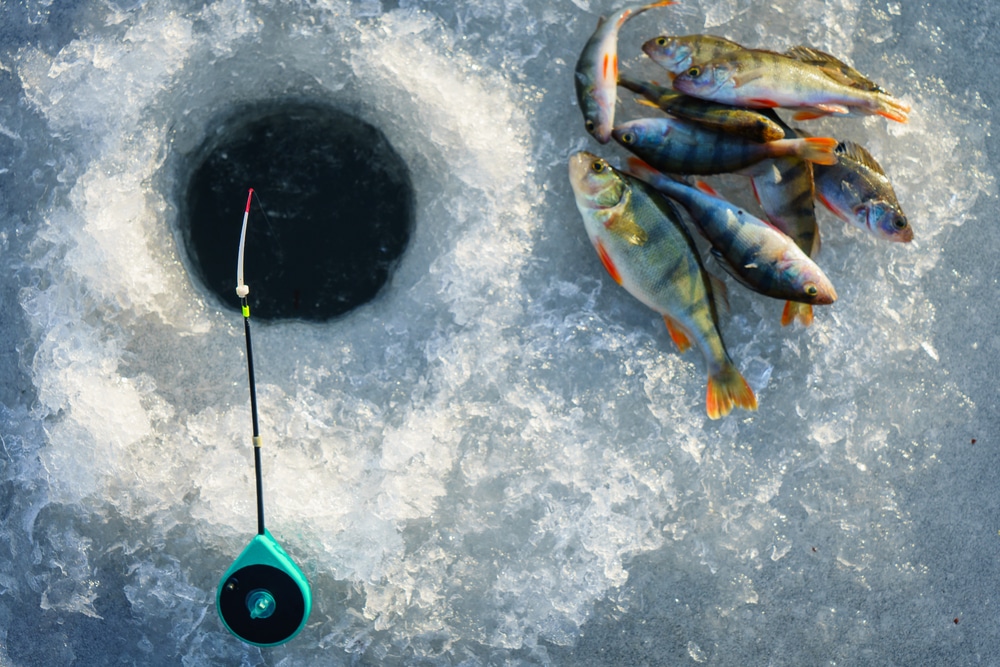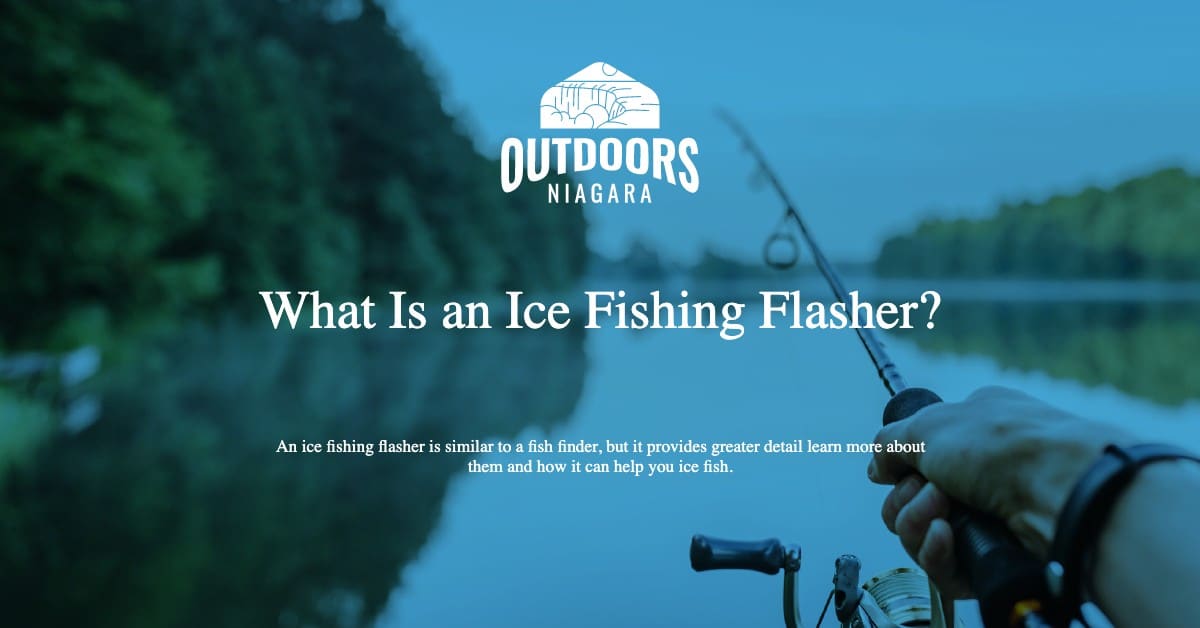An ice fishing flasher is similar to a fish finder, but it provides greater detail and the data from the flasher is presented in a circular pattern with various colors.
The colors which range from green to red indicate different things within the water column.
Red is a hard surface. Green is a soft surface, and yellow is a medium surface.
When you look at a flasher, you see pulsing colors.
The top of the water is shown as red and the bottom of the lake is also shown as red.
There is a dial of numbers that indicate water depth in feet making it easy to see exactly how deep the area of the lake where you ice fish is.
The flasher also will show your lure as it descends into the water giving you the opportunity to stop its descent at the right depth.
The data from the flasher also shows fish interacting with your lure.
So you know when to expect a strike and how effective a lure is based on the availability of fish and how they interact with the lure.
That data allows for greater success in ice fishing.

Contents
Why do I need a flasher for ice fishing?
Ice anglers need an ice flasher to show them a number of things.
Those include where the bottom, depth, lure position, and fish in the area.
Do you need a flasher to successfully ice fish? No. You can rely on good luck, and maybe you will do okay.
What an ice flasher does is it helps to take a lot of the guess work out of fishing.
You can see how much action one lure gets over another.
You can see where in the water column your lure is positioned.
You can see if fish come up to the lure and strike or if they just study the lure and leave.
You can also see underwater structures and whether fish are present.
Data allows you to learn and grow as an angler.
With greater insight into what happens under the ice, you can learn how to be a better angler and let’s face it – sitting on the ice all day and not catching fish is monotonous.

How does a flasher work ice fishing?
A flasher works based on sonar.
The transducer, which you lower into the water will use sonar to scan the bottom and read data.
The process happens in real-time which makes a flasher different from a fish finder.
The data from a fish finder, which is helpful, is also not in real time.
How do you use it?
You monitor how objects within the scope of the sonar more in relationship to the water column.
As you drop your lure into the water, the sonar will pick up the unit, and you can watch it drop deeper.
It will also show you the surface and the bottom allowing you to place your lure at the right depth.
It will show fish as they approach your lure, so you can anticipate the strike.
The flasher shows data and objects as different colors, which allows you to hone in on important features and target fish.
The data from the flasher is in real-time, so you can make immediate adjustments such as dropping the lure deeper, holding it in place, adding some altitude.
What are the features and what do they do?
On most ice fishing flashers there are six pieces or settings that you need to be aware of.
Those include the display, Transducers, Interference reducer, gain dial, range setting, and on some units a zoom feature.
Display
The display is where you read the information produced by the transducer.
It contains the sonar-cone information about your lure, the depth, the bottom, fish, and even structures.
Much of the display is read in different colored lights that indicate soft, medium, and hard surfaced.
The color bars can also indicate the size of objects within the sonar cone.
Red indicates the bottom which is both hard and large.
Green often indicates fish or plants, yellow can indicate plants, fish, or objects and yellow tends to be larger weed patches or schools of fish.
The Transducer
The transducer is the source of sonar. It is a float that is cabled to the unit and display.
It floats just at the surface of the bottom of the ice.
As you drop the transducer into the water, it bobs and sinks then stabilizes.
This is the juncture where you being to receive accurate data.
The data shows you the depth of the water, the position of the lure, and the activity of the fish.
Sonar is pitched in a cone-shape.
The narrowest part of the cone is the transducer and the widest area is along the bottom.
The data the flasher produces is a circular image of the water column from the surface to the bottom.
Thanks to various colored flashes, you can determine the surface and the bottom from fish, lure, and structures.
The transducer is influenced by the Gain Dial and will help you determine the proper depth of the water, so you can adjust the depth dial.
The Gain Dial
The gain dial is a range of 1-10. One being the weakest and ten being the strongest.
What the gain does is help to focus the data or image that the sonar produces.
It is a sensitivity dial so that the sonar can be better focused. It does this by removing distortion.
Adjust the gain dial as needed to improve the data from the sonar and until images are stabilized.
The Depth Dial
The Depth dial is just as its name implies. It allows you to set the cone depth of the sonar to the depth of the water.
The large bar of red, which indicates the bottom is what you read when setting the depth. If the red bottom bar is small, increase the depth. The first notch on the depth dial is generally 20 feet deep.
The depth dial allows you to define the scope of the sonar cone.
When you “dial” it in so that the correct depth is fixed, the sonar cone will produce more accurate data.
Interference Function
The interference function, if equipped on your flasher, helps to hone the quality of data from the sonar.
It is often in the form of a button.
If the color bars are not indicating accurately, try to engage the interference function.
Zoom
The zoom button, which is optional, allows you to split the display so that you can monitor different segments of the water column.
Usually, that is the bottom section and an upper section.
The zoom function enables you to fish smarter by being aware of what happens in different sections beneath the ice.
FAQ
Why is a flasher better for ice fishing?
The biggest advantage that an ice flasher brings to ice fishing is the detail and scope of easy to interpret data.
That includes depth of water, bottom, lure depth, and fish activity around the lure.
An ice flasher takes a lot of the guessing out of ice fishing and replaces it with real-time data, which allows you to adjust how you fish in real-time too.
Can you use a flasher through the ice?
You can use an ice flasher through the ice.
The trick is to make sure that the ice surface is wet.
The more water the better, the flasher will work.
So, while you can put the transducer directly on the ice and wet the area, it is much better to sink the transducer under the ice and let it do the work there.
What is the difference between a flasher and an LCD unit?
The biggest difference between a flasher and an LCD unit is the quality of the data you receive.
A flasher presents data in real-time where an LCD fish finder does not.
Also, it is much easier to visual what is happening beneath the water’s surface with a flasher than with an LCD unit.
The flasher allows you to see – in real-time – the movement of fish, the position of lure or bait, and the relationship of what is going on in the water column between the surface and the bottom.
An LCD fish finder gives you some of that data, but not in such detail and not in real-time.
A physical difference is found in how the two displays differ.
A flasher uses fiber optics powered by LED lights, whereas the LCD unit is, well, LCD and back lit.
The flasher requires less energy and the LED display shows up clearly in bright light.
The LCD unit requires a constant power source or frequent recharging and the LCD screen can be challenging in full sun.







